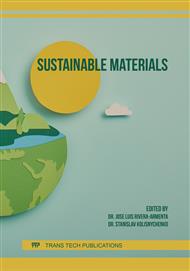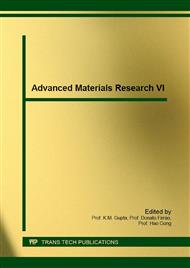p.103
p.108
p.114
p.121
p.126
p.133
p.138
p.143
p.148
Novel Bio-Based Composites Panels from TetraPak Waste
Abstract:
Due to the significant and harmful effect of the global warming on our communities, health, and climate, the usage of sustainable, bio-based and green materials became an imperative. On the other hand, the utilization of waste and biomass resources for developing new bio based composite materials is attracting much attention for the environmental and socio economics. Therefore, in this study, bio based composite panels from TetraPack® waste were developed. To enhance the mechanical and physical performances of TetraPak panels, sandwich structures were constructed. Mechanical and physical tests results showed significant improvements due to using sandwich structure in compare to No-skin structure. By comparing the developed TetraPak sandwich panels with the standard commercial particleboard, significant improvements in both mechanical and physical performances have been clearly observed. Consequently, the developed biocomposite TetraPak panels can be used in a wide variety of applications. Finely, this can be contributing in reducing environment contaminating, meanwhile introduce cheap and suitable product for different technical fields.
Info:
Periodical:
Pages:
138-142
Citation:
Online since:
April 2016
Authors:
Keywords:
Price:
Сopyright:
© 2016 Trans Tech Publications Ltd. All Rights Reserved
Share:
Citation:



